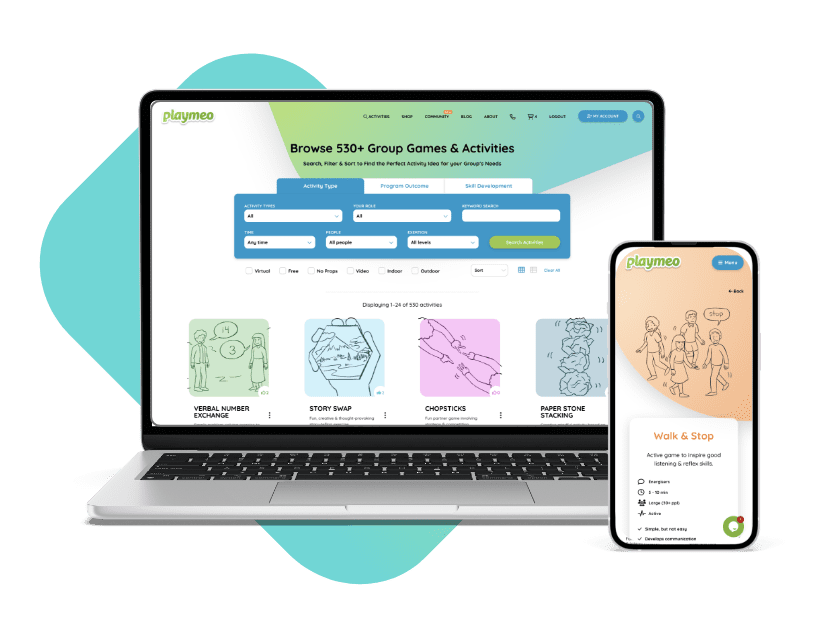If the term ‘unofficial start’ happens to be foreign to you, let me first provide a definition:
“… any strategy that facilitates early engagement & interaction and amplifies the purpose & productivity of your group and/or program…”
Unofficial starts are strategies as diverse as the groups and programs they aim to serve. These strategies aim not only to invite people to turn up on time and be quickly engaged but also to have fun, interact and provide opportunities for your group to build and strengthen their relationships.
At the end of the day, successful unofficial starts positively impact your group and your program objectives.
In this article, I want to tell you more about what unofficial starts are, what they look like, sound like and feel like. You can also explore lots of practical unofficial start ideas here.
First, allow me to take you back a few steps.
Background of the Unofficial Start
How often have you sat in a conference auditorium, ten minutes after the scheduled starting time, wondering when the program was going to start?
Or, you frequently have to wait 5 or 10 minutes before you start your program because you don’t like to (or can’t) start until most if not all of your participants are present.
Or, you often struggle with limited time and wonder how you could squeeze more value from your program.
I have been a part of, and experienced these very same feelings, wondering why it has to be this way. It doesn’t and the unofficial start could be just the tool you’ve been looking for.
Then This Happened…
Many years ago, I was working alongside a colleague in the United States to deliver a multi-day residential program. There were 24 participants expected to attend, yet ten minutes prior to the official start, less than a third of them had arrived.
Would we need to delay the start? This made sense, but what should we do? Seven people were already here. What to do?
My colleague Karl got started. Yep. He pulled out a bag of short ropes and invited those who were present to grab one each. This act alone immediately elevated the level of energy and interaction in the room.
Karl then invited each person, none of whom knew the others in the room, to find someone else with a similar coloured rope and show their partner how to tie a knot. Any knot. As simple or complex or useful as they chose.
Within moments, the energy in the room shifted significantly. Every individual had something to occupy them and focus their attention (this was before the advent of smartphones, a seriously addictive tool that has dispensed with the prospect of any of us ever being bored again.) Partners were talking and sharing and smiling and telling stories.
Now, while the use of rope and knots was somewhat related to the focus of this group’s training, none of this activity was essential to the success of the program. Except, it was. As I looked on with interest, I started to learn that this exercise had everything to do with the success of the program.
The concept of the ‘unofficial start’ was sparked in my mind…
This simple, ad hoc idea to invite people to play with ropes and share made a demonstrable difference to not only those who were present, but I also observed it make a significant impact on those who arrived from this point forward.
The looks on the faces of those arriving in the middle of this ‘unofficial start’ were telling. They were immediately engaged. They were visibly drawn to get involved as much as wonder what was happening in the room.
The typical response of someone noticing that the program had ‘started’ was to apologise for being late. Karl’s response was “You’re not late, you’re here!” And immediately invited them to pick up a rope and get started.
Every bit of this – the activity itself, the energy, the focus, the interaction and productivity – was instructive to me.
Karl and I had a choice. We could have waited, and just expected the early birds to keep themselves busy with polite chitter-chatter, as we wondered when the whole group would be present.
Or, we could take responsibility for generating such energy and interaction – and ultimately people’s attention – and get started.
What Does An Unofficial Start Look Like?
Unofficial starts are simple, easy and highly productive. To the uninitiated, they may seem like a revelation in programming technology, but they’re not rocket science.
In short, an unofficial start is any strategy that facilitates early engagement & interaction and amplifies the productivity of your group and/or program.
In one sense, the essential essence of a successful unofficial start flips the responsibility onto you, the program provider. It’s easy to point the finger at certain individuals or the group to explain why you’re not starting on time, or for the lack of energy or absence of positive feelings in the room.
Yes, you can wait until most of your group, or class, or conference, or training group, etc has arrived before you start. But, how’s that working out for you? Not so well I suspect.
Unofficial starts flip the responsibility for turning up on time on you. But it’s not onerous, it’s simply a shift of focus and perspective. And it works wonders. As simple as a bag of short ropes.
Unofficial starts amplify the productivity of idle time that would otherwise be wasted. Not so much a rule than a choice. You can choose to engage your group as soon as possible, or not. You can choose to invite opportunities for interaction, or not. The absence of these opportunities will not harm your program so much as deny its growth and the attraction of many other rewards.
We’ll talk more about the benefits in a moment, but for now, let’s take a look at…
What Makes an ‘Unofficial Start’ Successful
In my experience, the most powerful unofficial starts are those which feature one or more (hopefully all) of the following elements:
- Multiple choices to be engaged;
- Commitment to honour people’s choice, no matter what they choose to do (or not;)
- Simple set-ups;
- Activities that require low or no supervision;
- Experiences that are immediately attractive and non-threatening; and
- Ideally connected to the purpose of your gathering.
If you’re an experienced program provider, then you know it’s always easier to pull back too much energy, than it is to stimulate it. In my opinion, you can never have too much energy. Energy builds momentum and invites participation. It also helps to fuel positive emotions.
Unofficial starts generate much-needed energy, often distracting people from those awkward moments of not knowing what to do with oneself. They invite many opportunities (choices) for interaction, often shifting one’s attention to a non-threatening object, such as a rope, a card or a video.
They are also powerful motivators. In many long-term programs, I have used the principles of the unofficial start to influence the decisions of my group to be responsible for turning up on time, ie rather than punishing them for being late, I want to motivate them to be on time.
Kick off your program with a powerful first impression. Motivate your group to avoid the feeling of FOMO (fear of missing out.) Generate lots of valuable and rewarding interactions and help your group to connect with one another – all of which can only serve to amplify your program goals. And if nothing else, apply an unofficial start because it’s fun.
These and many more benefits are illustrated in the real-life examples which follow.
Unofficial Starts at Work
Here are eight useful illustrations of unofficial starts in a variety of settings, the principles of which you could apply to your own situation.
1. Learn To Surf Programs
I was commissioned by Surfing Australia to help them write a new training manual for their surf instructors. At first glance, this should appear very odd because I have never surfed in my life. But they approached me because they were looking for exemplary program design, one that engaged young people quickly and productively.
A problem experienced by most surf schools is what to do with those kids who arrive early for their surfing lesson, and how to motivate other students to turn up on time. Choosing to ‘start’ with a series of fun, engaging and low-supervision activities on the beach about ten minutes prior to the lesson was the key. Those who turned up early didn’t wander off while they waited for the lesson to start, eg rock pools were way more interesting than being bored. And the activities were so much fun, every kid pestered their parents to drop them off for their lesson on time lest they miss out on something.
2. Conference Openings
Three things occur at most conferences. Some people will be late, while many of those who have arrived on time are too busy to take their seat in the auditorium. And the organisers will invariably wait until most if not all of the delegates have been seated before they officially start. Enter, the unofficial start.
Imagine the impact of either ‘starting’ slightly before the scheduled start time, or starting on time and ‘filling’ the gap before the official start. It can sound like, “Hey folks, come on in. Allow me to make an unofficial start as we wait for a few stragglers to arrive….” Invite people to greet those around them, often folks they do not know. Ask them to respond to one more questions you pose from the podium, such as “Describe the image on your phone when you first turn it on” or “Where in the world do you describe as paradise?” Or invite them to engage in a quick game such as Gotcha, PDQ or the Clapping Game.
Within seconds, the energy in the room elevates exponentially. This serves many purposes. People are connecting, they are feeling more comfortable. Those who are lingering outside the auditorium are attracted inside. Those who are running late haven’t missed anything. And, based on the experience of both myself and other keynote presenters, there is nothing better than stepping into a room filled with healthy energy and people leaning in.
3. University Classes
I taught an adventure programming class at a major university for 7 years, a total of 14 semesters. As newly minted university students, they often had difficulty turning up to class on time, which annoyed me because I had a lot to share and never enough time to do this. While class participation was a part of their assessment, I chose not to apply a punitive approach to encourage students to get to class on time. Rather, I flipped this responsibility onto me – I worked hard to create an environment in which the students would want to turn up on time.
On most occasions, the room was empty before my class was scheduled to start, so I would often set up a series of activities in the room in advance of students arriving. Then, in true unofficial start fashion, there were a number of choices to keep students occupied as soon as they arrived. Better still, they were so engaging and so much fun, students wanted to be there. Indeed, sensing a FOMO experience (fear of missing out,) I noted that by the 4th or 5th week of each semester, I never had another late student. Bingo!
4. Virtual Meetings & Webinars
The health pandemic of COVID19 caused an explosion of online meetings (think Zoom) during 2020 and with it, a lot of wasted time as we all waited for the last few people to pull away from something more important than your meeting or session. Yawn! So much wasted time and so many missed opportunities for fun, engagement and valuable interaction. I had participated in a bunch of Zoom meetings, but it was not until April 2020 had I personally hosted a virtual event. And while I accepted that I would likely make a few rookie mistakes (and I did) I knew – without a doubt – that I had to engage participants in some form of unofficial start.
When all this started, we thought that wrangling the technology of adapting to a new, virtual medium was going to be the challenge. We were mistaken. The challenge was not getting used to Zoom but in harnessing and nourishing the humanity of our group. We were so focused on presenting our pixellated selves to the tiny camera atop of our computers, we forgot to connect with our group and invite them to connect with one another.
Virtual participants are the epitome of remote. To this end, I understood that their need to connect was even greater than any in-person or face-to-face program I could imagine. Accordingly, every virtual program or webinar I have conducted has embraced some form of unofficial start. Some of my most favourite examples include:
-
- Wordles – splashing them on the screen and inviting participants to solve them via the chatroom;
- Must Choose – conducting an online poll quizzing participants about lots of fun stuff;
- Colouring Pages – using the Annotate tool to beautify a virtual Mandala, or spaceship, country landscape, etc;
- Ice-Breaker Questions – inviting participants to share their responses to a series of interesting questions;
- Narration – reading short, engaging and always funny stories; and
- ID Numbers – inviting participants to present their version of an ID card.
5. Camp Meals
I worked as a leader of a major residential camp in the USA for eight summers. One of my biggest day-to-day issues was motivating kids to arrive at lunch on time. Punitive measures were both unnecessary and potentially harmful, so we chose instead to flip the responsibility for turning up on time to us.
We installed a large whiteboard directly inside the dining room door and every lunchtime posted a unique and engaging puzzle, question or challenge, such as Wordles, Alphabet Equations and riddles of the day. These quizzes were posted for a maximum of three minutes.
Campers sat with their cabin groups for all meals. There were attractive prizes for being the first to accurately respond to the various quizzes that we posted. But – and this was the kicker – only those cabins that had every camper present within the first three minutes of the meal could submit an answer.
As camp leaders, we no longer needed to manage late-comers. The most powerful, motivating force that compelled late campers to arrive on time was their peers. There was nothing worse than being the first cabin to crack the code of the day’s puzzle, and not being able to submit an answer because one or more campers (from their cabin) were missing.
These quizzes worked like a charm, but not because of peer pressure. The key was that these ‘unofficial starts’ were engaging, fun and attractive.
6. Training Program Starts
On most occasions, I deliver training programs in which the participants often dribble in one by one. Rarely is everyone present by the scheduled start time, and there are always some early birds. I choose to reward these early birds but also model a powerful programming principle. I get started as soon as I have a handful of people present.
In advance, I prepare the room with a set of puzzles, activities and props distributed throughout the room. They are often colourful, always engaging and certainly non-threatening. As soon as the first person arrives, these activities are attracting interest. When a small group are present, I invite my group on a little tour of what is available to keep them busy as “we wait for the stragglers.” Typically, and from this point forward, all I need to focus on is greeting more people as they arrive, and instruct them to find something that interests them and ask others what they are up to.
There are always a number of choices. I never expressly mention this at the start, but sitting in the corner sipping coffee, browsing their social media feed or chitty-chatting with a friend are all legitimate choices. My hope is that I have offered many more powerful and rewarding choices to these people. Why? Because the consequences which flow from each choice is starkly different.
7. Boozy Corporate Evenings
It was not uncommon to be engaged by many corporate groups to design and deliver one or more evening programs, for want of a better name. The scheduling of these programs, which were always interactive, fast-paced and extremely fun, served several purposes.
First, it gave people a reason to gather after dinner, long after the official purpose of the gathering (conference, strategy meeting, etc) was complete for the day. Second, the program provided many people with a productive activity, lest they retreat to their room, stream a video and not speak to another soul until breakfast the next day (hardly a team-building activity.)
Third, and possibly most importantly, it delayed the serious drinking sessions to later in the evening, causing fewer people to drink less alcohol in a shorter time than otherwise could have been the case. Often, the savings at the bar more than covered my professional fee.
The evening program served as a powerful unofficial start for the informal part of the (evening) program. It engaged people productively as much as it continued to build on the benefits of interaction and enjoying a fun time.
8. New Campers
Like most businesses, summer camps are always looking for new customers (campers.) In one camp I worked at, I observed some very powerful unofficial starts being applied to their camper population which really helped new campers settle in really quickly.
Ordinarily, a camper would have to wait all year to be introduced to their new summer camp. Then, having arrived often on their own, the task of assimilating and fitting can prove to be a daunting task. For this reason alone, homesickness is a serious issue for most long-stay residential camps.
Camp would start, months in advance, when new campers would be invited to a fun ‘get-to-know-you’ event involving a number of existing campers. Fun activities would be shared, videos shown and stories told. These events, not to mention a series of personal messages afterwards from different camp personnel, gradually built excitement for camp.
Then, travelling on the bus to camp, new campers would be invited to sit with other new campers to form new relationships. They’d watch a video (playing at the front of the bus) of the Camp Director telling them how excited he was for the coming summer and to meeting everyone onboard. And then finally, the new campers would step into camp. But in truth, camp had started many months ago.
9. Ballet School Venue
A teambuilding program was delivered for the very first time by a well-known ballet school teacher/choreographer. She used a venue familiar to her – the ballet school. As many of her corporate clients slowly trickled in, she took them on an engaging, walking tour of the historic photographs which lined the walls of the classroom she had hired for the day. Her clients were entranced in her stories, long after the training was supposed to ‘start.’
These examples, while clearly focused on specific types of populations and programs, have hopefully served as a powerful illustration of what is possible with your own programs.
To explore more practical ideas or if you have questions about how the principles of an unofficial start could apply to your programs, click one of the following links.






